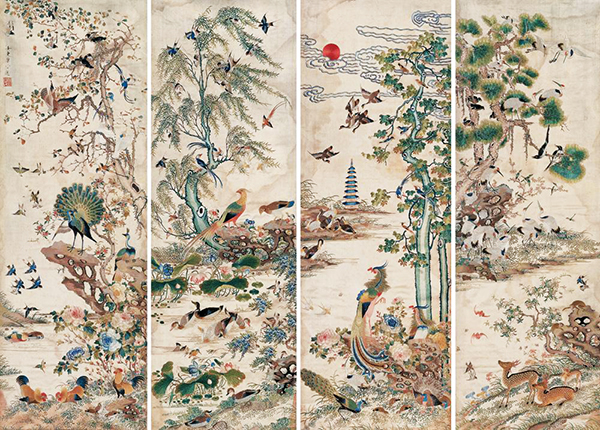Yue Embroidery

History
Among all the embroidery styles of China, the Guangdong style (Yue is the short term for Guangdong) may not be the best, but it is certainly the most special.
It originated from the Li, an ethnic group that lives in the area, and the needlework is traditionally done by men. Apart from its use of silk and floss, Guangdong embroidery is also known for its creative use of special materials such as peacock feathers and horsehair. The earliest records of Guangdong embroidery can be traced back to the Tang Dynasty (AD 618-907) and it certainly flourished in the Ming Dynasty. The largest piece of old Guangdong embroidery found by far is from the Qing Dynasty (1644-1911), which measured 4.2 meters long and 2.8 meters wide.
Compared to Suzhou-style embroidery which was heavily influenced by literati's love of shanshui, or the paintings of mountains and rivers, Guangdong embroidery is more on the people's hope for prosperity and peace, hence the popularity of emblems such as the dragon and phoenix, bats, peaches and other auspicious symbols. In the same vein, the colors are brighter and the palette more varied.
It is said that this style was one of the first to travel overseas, when in 1514, during the Ming Dynasty, Portuguese merchants brought back some pieces as a tribute to their king.
Since then, Guangdong embroidery slowly accumulated an unexpected fan base overseas, mostly from the European courts, which began collecting the pieces.
During the Qing Dynasty, some British businessmen brought their clothes to Guangdong and had them embroidered, starting a trend in which local embroiderers started to incorporate Western-style designs into their pattern books. Exports boomed.
By the time of the Qing emperors Yongzheng and Qianlong from the mid-17th century to the late 18th century, there were workshops catering specifically to the export markets of Europe and the Middle East.
Technique
Yue embroidered pieces can be done on silk or cotton. Early Chinese Yue artisans used peacock feathers, which had been twisted together as their thread, and this uniquely colorful material is still used as an accenting thread and as a way to blend separate objects in the design together. Another unique thread used is made from the tail of the horse; this coarse material is used to stitch an outline to the piece, which invites the eye to linger on the patterns, colors, and objects, making up the main design. This main design may be produced with either silk or cotton threads, and often features multiple objects or animals such as birds or dragons.
Although Yue embroidery is smooth, Yue crafters sometimes use gold and silver thread to create a three dimensional impression in their designs. As Yue embroidery has developed, it has often borrowed stylistic elements from other Chinese embroidery styles. Yue embroidery can also be sub-categorized into the Guang and Chao styles. These two styles are considered a part of the Yue embroidery "family" and have their own distinct stitching techniques.
Influenced by traditional folk art, Yue embroidery formed its own unique characteristics. The embroidered pictures are mainly of dragons and phoenixes, and flowers and birds, with neat designs and strong, contrasting colors. Floss, thread and gold-and-silk thread embroidery are used to produce costumes, decorations for halls and crafts for daily use.
